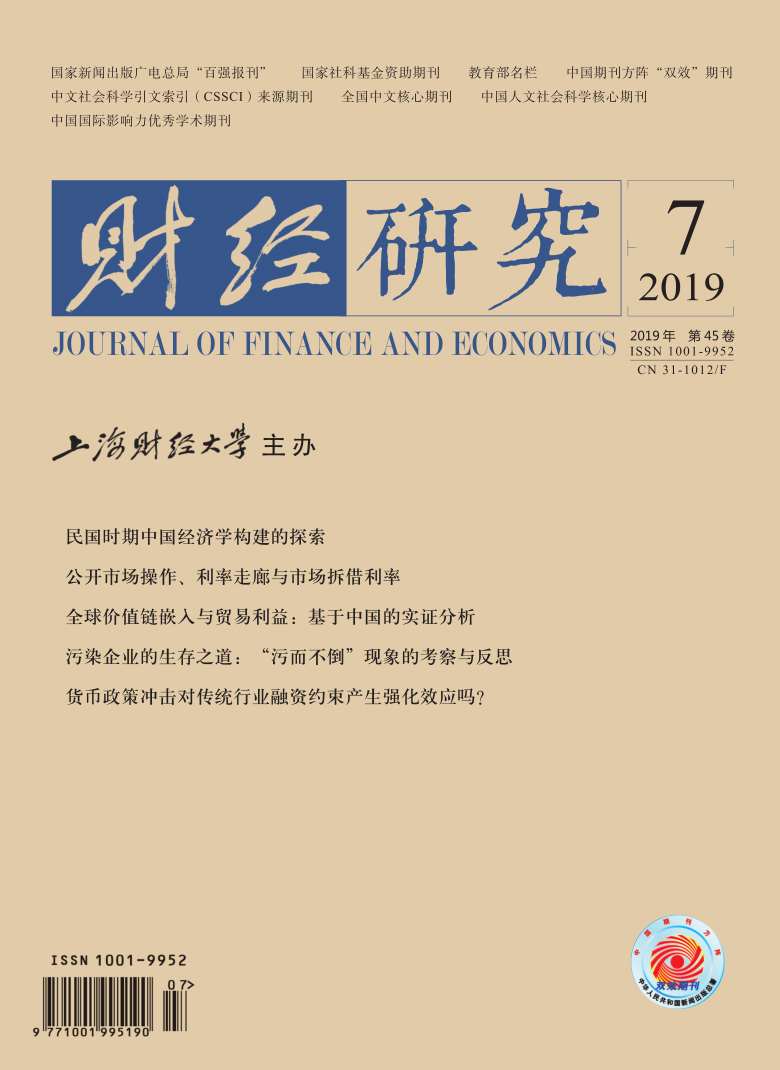The non-equilibrium of different economic entities under the impact of the monetary policy is the key to the transmission mechanism and effect of the monetary policy. Considering the large number of China’s labor force and its heterogeneity in the transitional period, the development of traditional industries has important strategic significance. It is generally believed that traditional industries will face more severe financing constraints in the context of the tightening monetary policy. However, this paper takes the textile industry as an example of theoretical and empirical analysis, and shows that the impact of the monetary policy on traditional industries includes two opposite aspects: industrial structure hierarchy effect and demand elasticity effect. The former will strengthen the financing constraints of traditional industries because of the relatively low industrial hierarchy of traditional industries, while the latter will relax the financing constraints because of the stability of demand. The specific results depend on the combination of the two effects. The empirical results show that the hierarchical effect of the industrial structure plays a more important role, so the tightening monetary policy strengthens the financing constraints of the textile industry, and this conclusion is robust both to expansionary and tightening monetary policies. The policy implications of the study are as follows: monetary policy-making should pay attention to both aggregate and structure; the monetary policy should consider the market correction of traditional industries; the perfection of market-oriented transmission of the monetary policy should depend on the promotion of the overall market-oriented reform of the economy.
 / Journals / Journal of Finance and Economics
/ Journals / Journal of Finance and EconomicsJournal of Finance and Economics
LiuYuanchun, Editor-in-Chief
ZhengChunrong, Vice Executive Editor-in-Chief
YaoLan BaoXiaohua HuangJun, Vice Editor-in-Chief
Do Monetary Policy Shocks Have a Reinforcing Effect on Traditional Industry Financing Constraints? A Case of the Textile Industry
Journal of Finance and Economics Vol. 45, Issue 07, pp. 125 - 139 (2019) DOI:10.16538/j.cnki.jfe.2019.07.010
Summary
References
Summary
[1] Chen G, Chen L M. Does fiscal decentralization ease financing constraints on local listed companies?[J]. Comparative Economic & Social Systems, 2016, (2): 11-25. (In Chinese)
[2] Dai G L, Deng J P, Zeng Y. Financial development, government control and financial restriction[J]. Management Review, 2012, (5): 21-29. (In Chinese)
[3] Gong M, Li W P. Assessing the role of aggregate demand and supply shocks in China’s macroeconomic fluctuation[J]. Economic Research Journal, 2007, (11): 32-44. (In Chinese)
[4] Huang G T, Zhao L Y. Supply disturbance, demand disturbance and business cycle effect: Empirical study based on Chinese data[J]. Journal of Financial Research, 2010, (6): 1-16. (In Chinese)
[5] Lin J H, Wang M J. Intensity and driving forces of macroeconomic fluctuations in the new normal[J]. Economic Research Journal, 2016, (5): 27-40. (In Chinese)
[6] Liu J Q. Studies of the effectiveness and asymmetry of monetary policy in China’s economy[J]. Management World, 2002, (3): 43-51. (In Chinese)
[7] Ma Y H. Innovating and integrating the textile industry chain, enhancing the competitiveness of the textile industry[J]. Economic Research Guide, 2009, (5): 35-37. (In Chinese)
[8] Ouyang Z G, Wang S J. The asymmetric reaction of monetary policy to inflation and real GDP in China[J]. Economic Research Journal, 2009, (9): 27-38. (In Chinese)
[9] Qi H D, Cao W, Zhao C. Monetary policy, local government quality and financial constraints: Based on the influence of monetary policy transmission mechanism[J]. Finance & Trade Economics, 2015, (4): 32-45. (In Chinese)
[10] Wang Q F, Yi Z H, Chen Y X, et al. Optimal choice of quantitative and price-based monetary policy instruments: Based on the asymmetric effects of monetary policy from a perspective of enterprises’property rights[J]. Journal of Financial Research, 2015, (6): 30-47. (In Chinese)
[11] Bernanke B, Gertler M. Agency costs, net worth, and business fluctuations[J]. The American Economic Review, 1989, 79(1): 14-31.
[12] Bernanke B S. Nonmonetary effects of the financial crisis in the propagation of the great depression [J]. The American Economic Review, 1983, 73(3): 257-276.
[13] Bernanke B S. Credit in the macroeconomy[J]. Federal Reserve Bank of New York Quarterly Review, 1993, 18(1): 50-70.
[14] Bernanke B S, Blinder A S. Credit, money, and aggregate demand[J]. The American Economic Review, 1988, 78(2): 435-439.
[15] Blalock G, Gertler P J, Levine D I. Financial constraints on investment in an emerging market crisis[J]. Journal of Monetary Economics, 2008, 55(3): 568-591.
[16] Den Haan W J, Sumner S W, Yamashiro G M. Bank loan portfolios and the monetary transmission mechanism[J]. Journal of Monetary Economics, 2007, 54(3): 904-924.
[17] Fazzari S M, Hubbard R G, Petersen B C. Financing constraints and corporate investment[J]. Brookings Papers on Economic Activity, 1988, (1): 141-195.
[18] Gertler M. Financial structure and aggregate economic activity: An overview[J]. Journal of Money, Credit and Banking, 1988, 20(3): 559-588.
[19] Kashyap A K, Stein J C. Monetary policy and bank lending[R]. NBER Working Paper No.4317, 1993.
[20] Lamont O. Cash flow and investment: Evidence from internal capital markets[J]. The Journal of Finance, 1997, 52(1): 83-109.
[21] Miron J A, Romer C D, Weil D N. Historical perspectives on the monetary transmission mechanism[R]. NBER Working Paper No.4326, 1993.
Cite this article
Zhan Minghua, Luo Chengjian, Li Shuai, et al. Do Monetary Policy Shocks Have a Reinforcing Effect on Traditional Industry Financing Constraints? A Case of the Textile Industry[J]. Journal of Finance and Economics, 2019, 45(7): 125-139.
Export Citations as:
For
ISSUE COVER
RELATED ARTICLES




 , 2
, 2 6935
6935  8226
8226

